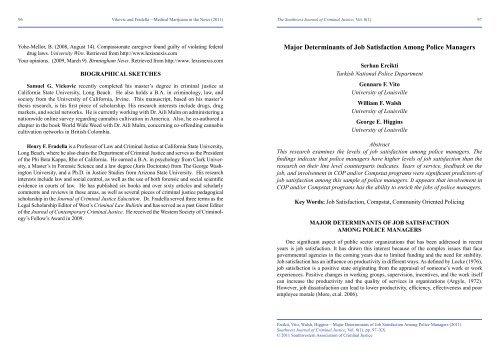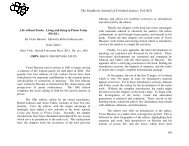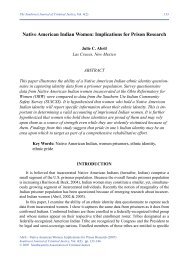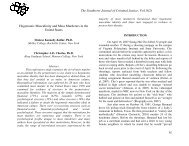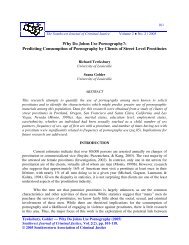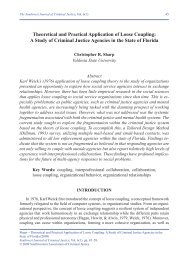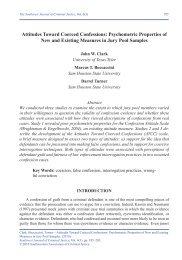major Determinants of Job Satisfaction among police ... - Swacj.Org
major Determinants of Job Satisfaction among police ... - Swacj.Org
major Determinants of Job Satisfaction among police ... - Swacj.Org
You also want an ePaper? Increase the reach of your titles
YUMPU automatically turns print PDFs into web optimized ePapers that Google loves.
96 Vikovic and Fradella—Medical Marijuana in the News (2011)<br />
The Southwest Journal <strong>of</strong> Criminal Justice, Vol. 8(1) 97<br />
Yohe-Mellor, B. (2008, August 14). Compassionate caregiver found guilty <strong>of</strong> violating federal<br />
drug laws. University Wire. Retrieved from http://www.lexisnexis.com<br />
Your opinions. (2009, March 9). Birmingham News. Retrieved from http://www. lexisnexis.com<br />
Biographical SketchES<br />
Samuel G. Vickovic recently completed his master’s degree in criminal justice at<br />
California State University, Long Beach. He also holds a B.A. in criminology, law, and<br />
society from the University <strong>of</strong> California, Irvine. This manuscript, based on his master’s<br />
thesis research, is his first piece <strong>of</strong> scholarship. His research interests include drugs, drug<br />
markets, and social networks. He is currently working with Dr. Aili Malm on administering a<br />
nationwide online survey regarding cannabis cultivation in America. Also, he co-authored a<br />
chapter in the book World Wide Weed with Dr. Aili Malm, concerning co-<strong>of</strong>fending cannabis<br />
cultivation networks in British Colombia.<br />
Henry F. Fradella is a Pr<strong>of</strong>essor <strong>of</strong> Law and Criminal Justice at California State University,<br />
Long Beach, where he also chairs the Department <strong>of</strong> Criminal Justice and serves as the President<br />
<strong>of</strong> the Phi Beta Kappa, Rho <strong>of</strong> California. He earned a B.A. in psychology from Clark University,<br />
a Master’s in Forensic Science and a law degree (Juris Doctorate) from The George Washington<br />
University, and a Ph.D. in Justice Studies from Arizona State University. His research<br />
interests include law and social control, as well as the use <strong>of</strong> both forensic and social scientific<br />
evidence in courts <strong>of</strong> law. He has published six books and over sixty articles and scholarly<br />
comments and reviews in these areas, as well as several pieces <strong>of</strong> criminal justice pedagogical<br />
scholarship in the Journal <strong>of</strong> Criminal Justice Education. Dr. Fradella served three terms as the<br />
Legal Scholarship Editor <strong>of</strong> West’s Criminal Law Bulletin and has served as a past Guest Editor<br />
<strong>of</strong> the Journal <strong>of</strong> Contemporary Criminal Justice. He received the Western Society <strong>of</strong> Criminology’s<br />
Fellow’s Award in 2009.<br />
Major <strong>Determinants</strong> <strong>of</strong> <strong>Job</strong> <strong>Satisfaction</strong> Among Police Managers<br />
Serhan Ercikti<br />
Turkish National Police Department<br />
Gennaro F. Vito<br />
University <strong>of</strong> Louisville<br />
William F. Walsh<br />
University <strong>of</strong> Louisville<br />
George E. Higgins<br />
University <strong>of</strong> Louisville<br />
Abstract<br />
This research examines the levels <strong>of</strong> job satisfaction <strong>among</strong> <strong>police</strong> managers. The<br />
findings indicate that <strong>police</strong> managers have higher levels <strong>of</strong> job satisfaction than the<br />
research on their line level counterparts indicates. Years <strong>of</strong> service, feedback on the<br />
job, and involvement in COP and/or Compstat programs were significant predictors <strong>of</strong><br />
job satisfaction <strong>among</strong> this sample <strong>of</strong> <strong>police</strong> managers. It appears that involvement in<br />
COP and/or Compstat programs has the ability to enrich the jobs <strong>of</strong> <strong>police</strong> managers.<br />
Key Words: <strong>Job</strong> <strong>Satisfaction</strong>, Compstat, Community Oriented Policing<br />
<strong>major</strong> determinants <strong>of</strong> job satisfaction<br />
<strong>among</strong> <strong>police</strong> managers<br />
One significant aspect <strong>of</strong> public sector organizations that has been addressed in recent<br />
years is job satisfaction. It has drawn this interest because <strong>of</strong> the complex issues that face<br />
governmental agencies in the coming years due to limited funding and the need for stability.<br />
<strong>Job</strong> satisfaction has an influence on productivity in different ways. As defined by Locke (1976),<br />
job satisfaction is a positive state originating from the appraisal <strong>of</strong> someone’s work or work<br />
experiences. Positive changes in working groups, supervision, incentives, and the work itself<br />
can increase the productivity and the quality <strong>of</strong> services in organizations (Argyle, 1972).<br />
However, job dissatisfaction can lead to lower productivity, efficiency, effectiveness and poor<br />
employee morale (More, et.al. 2006).<br />
Ercikti, Vito, Walsh, Higgins—Major <strong>Determinants</strong> <strong>of</strong> <strong>Job</strong> <strong>Satisfaction</strong> Among Police Managers (2011)<br />
Southwest Journal <strong>of</strong> Criminal Justice, Vol. 8(1). pp. 97–XX.<br />
© 2011 Southwestern Association <strong>of</strong> Criminal Justice
98 Ercikti, Vito, Walsh and Higgins—Major Determinanta <strong>of</strong> <strong>Job</strong> <strong>Satisfaction</strong> Among Police Managers (2011) The Southwest Journal <strong>of</strong> Criminal Justice, Vol. 8(1)<br />
99<br />
literature review<br />
Police <strong>Job</strong> <strong>Satisfaction</strong><br />
Although the concept <strong>of</strong> job satisfaction has been extensively investigated in other<br />
pr<strong>of</strong>essions, empirical research conducted on job satisfaction <strong>among</strong> <strong>police</strong> <strong>of</strong>ficers has<br />
been limited (Bennett, 1997; Dantzker, 1994; Zhao et al., 1999). As Bennett maintained,<br />
job satisfaction is a “neglected but important and timely topic in <strong>police</strong> studies” (1997, p.<br />
296). Buzawa et al. (1994) stated that research on job satisfaction in policing is newer than<br />
similar research involving other pr<strong>of</strong>essions: only about 20 published articles treating job<br />
satisfaction as a dependent variable pertain directly to policing.” Dantzker (1994) argued that<br />
<strong>police</strong> job satisfaction literature is methodically and topically limited. Griffin, Dunbar, and<br />
McGill noted that “job satisfaction, which has long been recognized in private industry as a<br />
prerequisite for successful job performance, has been merely a slogan in <strong>police</strong> organizations”<br />
(1978, p. 77). Even a decade later, most criminal justice researchers agree that research on<br />
job satisfaction <strong>among</strong> <strong>police</strong> <strong>of</strong>ficers is subject to further investigation.<br />
There are several reasons why job satisfaction is important to <strong>police</strong> organizations. First,<br />
negative attitudes toward work can adversely affect job performance in both the quantity<br />
and quality <strong>of</strong> services provided. Thus, poor performance can impact <strong>police</strong>-community<br />
relations by adversely affecting public attitudes toward the <strong>police</strong> (Buzawa, Austin, &<br />
Bannon, 1994). In addition to a moral obligation to demonstrate concern for its employees<br />
and promote positive work-related attitudes, job satisfaction promotes lower stress levels<br />
and, accordingly, fewer symptoms <strong>of</strong> stress (e.g., absenteeism, burnout, and alcoholism)<br />
(Hoath et al., 1998: 338). Police <strong>of</strong>ficers can experience high rates <strong>of</strong> employee turnover<br />
due to their low job satisfaction (Zhao et al. 1999). Loo’s (2004: 162) study <strong>of</strong> 135 male<br />
Canadian <strong>police</strong> mangers determined that a substantial portion <strong>of</strong> the respondents (34.1%) fit<br />
the pr<strong>of</strong>ile <strong>of</strong> high burnout “distressed <strong>police</strong> managers” that warranted some significant type<br />
<strong>of</strong> organizational intervention. As a result <strong>of</strong> high employee turnover, increased recruitment<br />
and training expenses for new <strong>police</strong> applicants may harm the limited budgets <strong>of</strong> law<br />
enforcement agencies, thus endangering the effectiveness <strong>of</strong> public safety. Consequently,<br />
research on job satisfaction <strong>among</strong> <strong>police</strong> <strong>of</strong>ficers may provide valuable information that can<br />
improve the quality <strong>of</strong> <strong>police</strong> services.<br />
According to Herzberg (1959), different factors combine to create job satisfaction and<br />
dissatisfaction <strong>among</strong> employee. He identified these as either motivators or hygiene factors.<br />
Motivators promote job satisfaction. They include: (a) achievement, (b) responsibility, (c)<br />
the work itself, (d) recognition, and (e) advancement/promotion. Hygiene factors do not<br />
directly lead to job satisfaction <strong>among</strong> employees. However, their absence may lead to job<br />
dissatisfaction. They consist <strong>of</strong>: (a) organizational policies, (b) supervision and leadership,<br />
(c) pay or salary, (d) work conditions, (e) communication with supervisors/work partners.<br />
Herzberg contended that employees need to reach an acceptable level <strong>of</strong> hygiene factors<br />
to feel neutral about their jobs. Therefore, employers should seek ways <strong>of</strong> eliminating<br />
dissatisfaction resulting from hygiene factors and focus on improving the motivators in the<br />
work environment to increase job satisfaction. Zhao and his colleagues (1999: 154) stated<br />
that Herzberg’s (1968) two-factor theory <strong>of</strong> job satisfaction “provides a useful theoretical<br />
framework for empirically assessing <strong>of</strong>ficers’ job satisfaction.” They further suggested that<br />
a comprehensive examination <strong>of</strong> job satisfaction not only should cover organizational (work<br />
environment) variables but also certain job characteristics and employees’ demographic<br />
characteristics.<br />
Hackman and Oldham (1975) suggest that changes in intrinsic work environments lead<br />
to higher levels <strong>of</strong> motivation and satisfaction <strong>among</strong> employees. Their theory includes three<br />
constructs: (1) core job characteristics, (2) critical psychological states, and (3) outcomes.<br />
Core job characteristics include: (a) skill variety, (b) task identity, (c) task significance, (d)<br />
autonomy, and (e) feedback. If employers adequately provide these five job characteristics,<br />
employees will experience three critical psychological states: (1) meaningfulness <strong>of</strong> the job,<br />
(2) responsibility <strong>of</strong> outcomes <strong>of</strong> work activities, and (3) knowledge <strong>of</strong> work outcomes.<br />
These three critical psychological states then lead to positive outcomes, such as: (a) higher<br />
internal motivation, (b) higher growth job satisfaction, (c) higher general job satisfaction and<br />
d) increased productivity and less absenteeism and turnover. They also argued that employees<br />
experience satisfaction when they have autonomy and discretion on the job. Timely and/or<br />
positive feedback regarding their job activities as well as the knowledge that their work<br />
outcomes are helpful for others also promotes job satisfaction. In addition, job challenges that<br />
require a variety <strong>of</strong> skills enrich and enlarge the job and elevate job satisfaction. Hackman and<br />
Oldham (1980) developed a measurement scale, the <strong>Job</strong> Diagnostic Scale (JDS) to measure<br />
job satisfaction levels <strong>of</strong> employees using the five core job characteristics.<br />
Prior research regarding the <strong>major</strong> determinants (demographic and organizational<br />
variables) on <strong>police</strong> job satisfaction is inconsistent. Consensus has not been reached about<br />
which demographic variables significantly predict job satisfaction. Zhao et al. (1999) pointed<br />
out that there has been very limited research on the relationship the work environment has on<br />
<strong>police</strong> and their job satisfaction levels. The most commonly used demographic variables in<br />
<strong>police</strong> job satisfaction are: age, gender, race, educational attainment, rank, and length <strong>of</strong> service<br />
(Zhao et al., 1999). For example, while some researchers maintained that age is significantly<br />
correlated with job satisfaction <strong>among</strong> <strong>police</strong> <strong>of</strong>ficers (Dantzker, 1994), other researchers<br />
<strong>of</strong>fered mixed findings (Buzawa et al., 1994). Similarly, researchers reported inconsistent<br />
findings with gender (Aremu & Adeyoju, 2003; Bennett, 1997; Burke & Mikkelsen, 2004;<br />
Buzawa et al., 1994; Dantzker, 1994; Grant, Garrison & McCormick, 1990).<br />
Dantzker’s (1994) job satisfaction survey <strong>of</strong> twelve <strong>police</strong> departments in six states (N<br />
= 552) indicated that <strong>police</strong> <strong>of</strong>ficer participants had low overall job satisfaction levels. They<br />
reported the greatest dissatisfaction with the pay and the least dissatisfaction with supervisory<br />
support. Police <strong>of</strong>ficers between the ages <strong>of</strong> 20 and 25 were more satisfied than other age<br />
groups. The male <strong>police</strong> <strong>of</strong>ficers had higher job satisfaction levels than female <strong>police</strong> <strong>of</strong>ficers.<br />
The men were more likely to change <strong>police</strong> departments, while the women were more likely<br />
to accept a job <strong>of</strong>fer different from policing. Police <strong>of</strong>ficers with the rank <strong>of</strong> sergeant had<br />
the lowest satisfaction level compared to other <strong>police</strong> <strong>of</strong>ficers. While the education level<br />
<strong>of</strong> <strong>police</strong> <strong>of</strong>ficers did not have a significant impact on job satisfaction levels, the findings<br />
indicated a weak relationship between education and job satisfaction. Finally, ethnicity/race<br />
and age had the greatest impact on the <strong>police</strong> <strong>of</strong>ficers’ perceptions <strong>of</strong> job satisfaction. Black<br />
<strong>of</strong>ficers reported greater satisfaction than did their white colleagues.<br />
Other studies found that education had an inconsistent affect upon <strong>police</strong> job satisfaction.<br />
Some researchers found a positive correlation between education level and job satisfaction
100 Ercikti, Vito, Walsh and Higgins—Major Determinanta <strong>of</strong> <strong>Job</strong> <strong>Satisfaction</strong> Among Police Managers (2011) The Southwest Journal <strong>of</strong> Criminal Justice, Vol. 8(1)<br />
101<br />
<strong>among</strong> <strong>police</strong> <strong>of</strong>ficers (Dantzker, 1992; Carlan, 1999). Lefkowitz (1974) reported a negative<br />
relationship between job satisfaction and education level <strong>of</strong> <strong>police</strong> <strong>of</strong>ficers. Other researchers<br />
reported that education level did not have a significant effect on job satisfaction <strong>among</strong><br />
<strong>police</strong> <strong>of</strong>ficers (Griffin, Dunbar, & McGill, 1978). The same inconsistent pattern was present<br />
for rank and length <strong>of</strong> service. Some researchers reported a negative relationship between<br />
rank and length <strong>of</strong> service and job satisfaction <strong>among</strong> <strong>police</strong> <strong>of</strong>ficers (Buzawa et al., 1994;<br />
Dantzker, 1992, 1994; Hoath, Schneider & Starr, 1998; Brunetto & Farr-Wharton, 2003)<br />
while others reported the opposite (Burke, 1989) or no relationship (Bennett, 1997).<br />
<strong>Org</strong>anizational psychologists have investigated job satisfaction and its influence on<br />
different organizational factors, such as absenteeism, employee turnover, productivity,<br />
pay, skill variety, task identity, autonomy, supervision, and promotion. Commonly used<br />
organizational variables to measure job satisfaction perceptions <strong>among</strong> <strong>police</strong> <strong>of</strong>ficers:<br />
a) equipment, b) pay, c) promotion, d) work environment (skill variety, task identity, task<br />
significance, autonomy, and feedback), e) supervisor relations, f) work-family conflict, g)<br />
stress, and h) management policies (Dantzker, 1994).<br />
These organizational variables have had differing impacts upon <strong>police</strong> job satisfaction.<br />
Slovak (1978) found that work satisfaction <strong>among</strong> <strong>police</strong> <strong>of</strong>ficers was multidimensional<br />
and was mostly determined by: (a) equipment/preparation, (b) compensation /advancement,<br />
and (c) management/organization. Dantzker and Surrette (1996) determined that the <strong>police</strong><br />
<strong>of</strong>ficers were least satisfied with pay and availability <strong>of</strong> in-service training but they were<br />
most satisfied with their present assignment and immediate supervisor support. Dantzker<br />
(1997) reported that organizational size had an impact on <strong>police</strong> <strong>of</strong>ficer job satisfaction.<br />
Police <strong>of</strong>ficers from agencies that employed less than 100 sworn <strong>of</strong>ficers had the highest<br />
job satisfaction levels <strong>among</strong> the three groups <strong>of</strong> agencies. Police <strong>of</strong>ficers from agencies<br />
that employed more than 500 sworn <strong>of</strong>ficers had the lowest job satisfaction levels <strong>among</strong><br />
the three groups <strong>of</strong> agencies. Brunetto and Farr-Wharton (2002) found that pay, dealing<br />
with clientele, and organizational management practices (promotion, appraisal, and other<br />
procedures) decreased <strong>police</strong> <strong>of</strong>ficer job satisfaction. Howard, Don<strong>of</strong>rio and Boles (2004)<br />
reported that work-family conflict was a strong predictor <strong>of</strong> different aspects <strong>of</strong> <strong>police</strong> job<br />
satisfaction.<br />
Mire (2005) surveyed 87 <strong>police</strong> <strong>of</strong>ficers from Lafayette, Louisiana to determine correlates<br />
<strong>of</strong> their job satisfaction. In addition to demographic variables, organizational (e.g., task<br />
identity, skill variety, task significance, autonomy, and feedback), and personality variables<br />
(e.g., neuroticism, extraversion, and openness) were considered. Age, years <strong>of</strong> service, and<br />
rank was significantly correlated to job satisfaction. Also, all <strong>of</strong> the five organizational<br />
variables had significant correlations with job satisfaction, explaining 13% <strong>of</strong> the variance.<br />
Personality variables could explain only 10% <strong>of</strong> the variance in <strong>police</strong> job satisfaction.<br />
Another organizational variable is the stated purpose <strong>of</strong> the department. Innovations in<br />
policing, such as community policing, have contributed to job satisfaction. The relationship<br />
between the two, however, is complex. Some studies have examine the impact <strong>of</strong> community<br />
oriented policing upon job satisfaction. Adams, Rohe, and Arcury (2002) found that<br />
community <strong>police</strong> <strong>of</strong>ficers were more positive about their assignments, more accepting <strong>of</strong><br />
different policing strategies, more optimistic about the impact <strong>of</strong> COP on <strong>police</strong>-community<br />
relations, and were more satisfied with their jobs compared to traditional <strong>police</strong> <strong>of</strong>ficers.<br />
Halsted, Bromley, and Cochran (2000) reported that deputies with strong orientations for<br />
community service had higher job satisfaction levels than deputies with strong crime control<br />
orientations. Ford and his colleagues (2003) determined that a sample <strong>of</strong> Midwestern <strong>police</strong><br />
<strong>of</strong>ficers’ job satisfaction was directly related to their commitment to their organization.<br />
Yet, their level <strong>of</strong> commitment to a community policing strategy was unrelated to their job<br />
satisfaction but strongly related to their behaviors in support <strong>of</strong> the strategy.<br />
Another organizational paradigm is <strong>of</strong>fered by Compstat (Walsh, 2001, p. 352):<br />
At the core <strong>of</strong> the Compstat process is a computerized information dissemination system,<br />
which is expected to process, map and analyze weekly crime and disorder statistics. This<br />
information is then sent to operational managers in a timely fashion, usually once a week.<br />
These operational managers are empowered and held accountable to focus, manage, and<br />
direct their organizational sub-unit’s problem-solving process towards addressing the<br />
crime and disorder issues associated with this data.<br />
the present study<br />
The present study considers the impact <strong>of</strong> these variables upon <strong>police</strong> job satisfaction.<br />
The purpose <strong>of</strong> this study was to investigate the <strong>major</strong> determinants (demographic and<br />
organizational variables) <strong>of</strong> job satisfaction <strong>among</strong> <strong>police</strong> managers. The <strong>major</strong> research<br />
questions were:<br />
1. What is the relationship between organizational variables (skill variety, task identity,<br />
task significance, autonomy, and feedback) and the job satisfaction perceptions <strong>of</strong> <strong>police</strong><br />
managers?<br />
2. What is the relationship between demographic variables and organizational variables<br />
explaining the variance in the job satisfaction perceptions <strong>of</strong> <strong>police</strong> managers?<br />
3. What is the impact <strong>of</strong> participation in COP/COMPSTAT programs on the job<br />
satisfaction perceptions <strong>of</strong> <strong>police</strong> managers?<br />
methods<br />
Sample and Procedures<br />
The data for this study were obtained from <strong>police</strong> managers attending the Administrative<br />
Officers’ Course (AOC) or the Commanding Officer Development Course (CODC) <strong>of</strong>fered<br />
by the Southern Police Institute (SPI) under the Department <strong>of</strong> Justice Administration at<br />
the University <strong>of</strong> Louisville. This convenience sample <strong>of</strong> 136 <strong>of</strong>ficers (91% response rate)<br />
represented 24 states. After approval from the Institutional Review Board, the managers<br />
voluntarily completed a self-report survey that contains several measures.<br />
Measures<br />
<strong>Job</strong> <strong>Satisfaction</strong><br />
We used Dantzker’s (1993) job satisfaction scale as the dependent measure for this<br />
study. The measure consisted <strong>of</strong> 23-items, and the respondents indicated their agreement
102 Ercikti, Vito, Walsh and Higgins—Major Determinanta <strong>of</strong> <strong>Job</strong> <strong>Satisfaction</strong> Among Police Managers (2011) The Southwest Journal <strong>of</strong> Criminal Justice, Vol. 8(1)<br />
103<br />
to the items using a 5-point Likert-type format that was anchored by strongly disagree (1)<br />
to strongly agree (5). The measure captured job satisfaction information on six dimensions<br />
<strong>of</strong> job satisfaction (i.e., supervision, salary, recognition, equipment, education, and job<br />
position). Dantzker (1993) used this version <strong>of</strong> the measure as a unidimensional measure <strong>of</strong><br />
job satisfaction. The internal consistency for the measure was appropriate 0.85, and higher<br />
scores indicated higher levels <strong>of</strong> job satisfaction.<br />
Task Identity<br />
We used a measure <strong>of</strong> task identity. The measure is a subscale that came from Burke’s<br />
(2007) version <strong>of</strong> the job diagnostic scale. The items that comprised this measure were: My<br />
job allows me the opportunity to complete the work I started; My job is arranged so that I<br />
have a chance and the ability to talk with customers/clients/and users; My job is arranged<br />
so that I have an understanding <strong>of</strong> how it relates to the business mission. The respondents<br />
indicated their responses to these items using a 7-point Likert-type scale that was anchored<br />
by strongly disagree (1) to strongly agree (7). Higher scores indicated more identification<br />
with a particular task. The internal consistency for this measure was low 0.43, but this is<br />
consistent with the Burke’s (2007) use <strong>of</strong> the measure.<br />
Task Significance<br />
Our measure <strong>of</strong> task significance is a subscale that came from Burke’s (2007) version <strong>of</strong><br />
the job diagnostic scale. The items that comprised this measure were: My job is one that<br />
may affect a lot <strong>of</strong> other people by how well the work is performed; My job has the ability<br />
to influence decisions that significantly affect the organization; My job influences day-to-day<br />
company success. The respondents indicated their responses to these items using a 7-point<br />
Likert-type scale that were anchored by strongly disagree (1) to strongly agree (7). Higher<br />
scores indicated more significance with a particular task. The internal consistency for this<br />
measure was low 0.63, but this is consistent with the Burke’s (2007) use <strong>of</strong> the measure.<br />
Skill Variety<br />
Our measure <strong>of</strong> skill variety is a subscale from Burke’s (2007) job diagnostic scale. The<br />
items that make up our skill variety scale are: My job provides me much variety; While<br />
performing my job I get the opportunity to work on many interesting projects; My job gives<br />
me the opportunity to use many new technologies. The respondents indicated their responses<br />
to these items using a 7-point Likert-type scale that were anchored by strongly disagree (1)<br />
to strongly agree (7). Higher scores indicated more skill variety with a particular task. The<br />
internal consistency for this measure was 0.72 and was acceptable.<br />
Autonomy<br />
We used a measure <strong>of</strong> autonomy that was a subscale from Burke’s (2007) job diagnostic<br />
scale. The items that we used for this measure were: My job lets me be left on my own<br />
to do my own work; My job provides me the opportunity <strong>of</strong> self-directed flexibility <strong>of</strong> work<br />
hours; I am able to act independently <strong>of</strong> my supervisor in performing my job function. The<br />
respondents indicated their responses to these items using a 7-point Likert-type scale that<br />
were anchored by strongly disagree (1) to strongly agree (7). Higher scores indicated more<br />
autonomy with a particular task. The internal consistency for this measure was low 0.46,<br />
but this is consistent with the Burke’s (2007) use <strong>of</strong> the measure.<br />
Feedback<br />
We used a measure feedback that was a subscale from Burke’s (2007) job diagnostic<br />
scale. The items that we used for this measure were: My job by itself provides feedback<br />
on how well I am performing as I am working; My job provides me with the opportunity<br />
to both communicate with my supervisor and to receive recognition from them as well; I<br />
receive feedback from my co-workers about my performance on the job. The respondents<br />
indicated their responses to these items using a 7-point Likert-type scale that were anchored<br />
by strongly disagree (1) to strongly agree (7). Higher scores indicated more feedback. The<br />
internal consistency for this measure was low 0.59, but this is consistent with the Burke’s<br />
(2007) use <strong>of</strong> the measure.<br />
Demographics<br />
We used a number <strong>of</strong> demographic measures in our study. For instance, we used sex<br />
(0) female and (1) male. Marital status was captured using (0) not married and (1) married.<br />
Ethnicity was captured using (0) non-white and (1) white. We captured education using a<br />
3-point scale: (1) low [some college, HS diploma, or GED], (2) medium [college graduate],<br />
and (3) high [some pr<strong>of</strong>essional and pr<strong>of</strong>essional graduate]. We captured rank using a<br />
3-point scale: (1) low [sergeant], (2) medium [lieutenant], and (3) high [captain or <strong>major</strong>].<br />
The age <strong>of</strong> the <strong>of</strong>ficer and years <strong>of</strong> service was captured using an open-ended format.<br />
analysis<br />
The analysis plan for this article takes place in a series <strong>of</strong> steps. The first step is a<br />
presentation <strong>of</strong> the descriptive statistics that will allow us to discuss the distribution <strong>of</strong> the<br />
measures. The descriptive statistics that we use are the mean and the standard deviations.<br />
The second step in the analysis is a presentation <strong>of</strong> the bivariate correlations <strong>of</strong> the measures.<br />
This will allow us to examine the association between the measures. Further, the bivariate<br />
correlations will also provide an early indication <strong>of</strong> multicollinearity. The third step is a<br />
presentation <strong>of</strong> regression analysis. Because the data are cross-sectional, the regression<br />
analysis provides information about the link between the job satisfaction (i.e., dependent<br />
measure) and the other measures (i.e., independent measures). Because multiple independent<br />
measures are being used in this study and many <strong>of</strong> them come from one diagnostic,<br />
multicollinearity is an important issue. To examine for multicollinearity, we will use the<br />
tolerance measure. Freund and Wilson (1998) argued that tolerance measures that 0.20 and<br />
below indicate multicollinearity.<br />
results<br />
Step 1: Descriptive Statistics<br />
The descriptive statistics for this study are presented in Table 1. The table shows that<br />
the average age <strong>of</strong> the <strong>of</strong>ficers is 40 years old, and 85 percent <strong>of</strong> the <strong>of</strong>ficers were male. The<br />
<strong>of</strong>ficers have 15 years <strong>of</strong> service. The <strong>of</strong>ficers have an average score that indicates that they<br />
are college graduates. Eighty percent <strong>of</strong> the <strong>of</strong>ficers that reported were white, and 83 percent<br />
<strong>of</strong> the <strong>of</strong>ficers were married. The average scores indicated that the <strong>of</strong>ficers agreed with the<br />
statements for skill variety, task identity, task significance, autonomy, and feedback. Finally,<br />
the average level <strong>of</strong> job satisfaction was high.
104 Ercikti, Vito, Walsh and Higgins—Major Determinanta <strong>of</strong> <strong>Job</strong> <strong>Satisfaction</strong> Among Police Managers (2011) The Southwest Journal <strong>of</strong> Criminal Justice, Vol. 8(1)<br />
105<br />
Table 1. Descriptive Statistics<br />
Variable Mean Standard Deviation<br />
Age 40.93 5.79<br />
Education 2.04 0.75<br />
Seniority 15.60 5.52<br />
Skill Variety 5.52 1.01<br />
Task Identity 5.88 0.83<br />
Task Significance 5.70 0.85<br />
Autonomy 5.47 1.02<br />
Feedback 5.39 1.01<br />
Sex 0.85 0.36<br />
Marital Status 0.83 --<br />
Rank 1.60 0.74<br />
Race 0.80 --<br />
<strong>Job</strong> <strong>Satisfaction</strong> 82.04 10.76<br />
Step 2: Correlations<br />
Table 2 presents the correlations <strong>of</strong> the measures. The correlations indicate that job<br />
satisfaction is associated with skill variety (r=0.30), task significance (r=0.29), autonomy<br />
(r=0.23), and feedback (r=0.34). This suggests that the scales <strong>of</strong> job diagnostics have a<br />
link with job satisfaction. In addition, COMPSTAT has a correlation (r=0.18) with job<br />
satisfaction. While these correlations indicate that there is an association between the<br />
theoretical independent measures and job satisfaction, we believe that it is important to point<br />
out that largest correlation occurs between feedback and autonomy (r=0.43). With this being<br />
the largest correlation, we believe that multicollinearity is not an issue in these data, but we<br />
will reserve our final judgment until the regression analysis.<br />
Step 3: Regression Analysis<br />
Table 3 presents the regression analysis for the present study. These results indicate that<br />
three measures have a link with job satisfaction. To clarify, the more seniority that an <strong>of</strong>ficer<br />
has the less job satisfaction they have with their job (b=-0.61, Beta=-0.31). As feedback<br />
increases job satisfaction increases (b=2.86, Beta=0.26). Finally, the use <strong>of</strong> COMPSTAT<br />
increased job satisfaction (b=8.30, Beta=0.23). This finding is consistent with previous<br />
research that COP <strong>of</strong>ficers had higher levels <strong>of</strong> job satisfaction and perceptions <strong>of</strong> autonomy<br />
than traditional <strong>of</strong>ficers (Adams, Rohe, and Arcury, 2002). 1 In addition, the tolerance levels<br />
were all above 0.20, suggesting that multicollinearity was a problem with these data.<br />
1. We were concerned about the small sample size and the number <strong>of</strong> independent variables. We performed<br />
a series <strong>of</strong> simulation studies in an attempt to determine if the parameters (i.e., slopes [b]) and standard errors<br />
were biased. We did not find bias in the parameters and standard errors. To operationalize our simulations,<br />
we used our results from the regression analysis, and had it replicated across 1000 samples. This allowed us<br />
to calculate bias per the suggestions from Muthen and Muthen (2002). We did this in two programs--Mplus<br />
and SAS, so our simulations are really 2000 samples from two different programs; thus, we feel confident that<br />
bias is not present given the small sample size.<br />
Table 2. Correlation Analysis<br />
Variable 1 2 3 4 5 6 7 8 9 10 11 12 13<br />
1. Age 1.00<br />
2. Education 0.12 1.00<br />
3. Seniority 0.68* 0.04 1.00<br />
4. Skill Variety 0.13 -0.03 0.11 1.00<br />
5. Task Identity 0.10 0.06 0.06 0.45* 1.00<br />
6. Task Significance 0.08 -0.08 0.08 0.43* 0.22* 1.00<br />
7. Autonomy 0.15 -0.04 0.20* 0.23* 0.30* 0.21* 1.00<br />
8. Feedback 0.04 -0.14 0.15 0.39* 0.19* 0.34* 0.43* 1.00<br />
9. Sex 0.05 -0.05 0.22* 0.03 0.01 0.03 -0.10 0.03 1.00<br />
10. Marital Status -0.04 -0.03 -0.05 -0.15 -0.17* -0.20* 0.14 -0.02 -0.30* 1.00<br />
11. Rank 0.36* -0.02 0.35* 0.17* 0.05 0.23* 0.12 -0.04 0.21* -0.06 1.00<br />
12. Race -0.14 0.02 -0.02 0.02 -0.02 0.10 0.08 0.13 0.01 0.02 -0.09 1.00<br />
13. COMPSTAT -0.09 -0.01 -0.03 0.08 -0.04 0.00 -0.00 0.00 -0.08 0.09 0.08 0.11 1.00<br />
14. <strong>Job</strong> <strong>Satisfaction</strong> 0.05 -0.04 -0.06 0.30* 0.14 0.29* 0.23* 0.34* 0.05 -0.10 0.09 -0.01 0.18* 1.00<br />
*p≤.05
106 Ercikti, Vito, Walsh and Higgins—Major Determinanta <strong>of</strong> <strong>Job</strong> <strong>Satisfaction</strong> Among Police Managers (2011) The Southwest Journal <strong>of</strong> Criminal Justice, Vol. 8(1)<br />
107<br />
Table 3. Regression Analysis<br />
Variable B Std. Error Beta Tolerance<br />
1. Age 0.38 0.21 0.20 0.48<br />
2. Education -0.04 0.90 -0.00 0.95<br />
3. Seniority -0.61* 0.23 -0.31 0.48<br />
4. Skill Variety 0.87 1.07 0.08 0.61<br />
5. Task Identity -0.35 1.20 -0.03 0.72<br />
6. Task Significance 1.97 1.20 0.15 0.70<br />
7. Autonomy 1.15 1.01 0.11 0.70<br />
8. Feedback 2.86* 1.06 0.26 0.65<br />
9. Sex 2.87 2.60 0.10 0.80<br />
10. Marital Status -1.39 2.55 -0.05 0.80<br />
11. Rank 0.77 1.36 0.05 0.74<br />
12. Race -1.17 2.25 -0.04 0.93<br />
13. OMPSTAT 8.30* 2.94 0.23 0.94<br />
*p≤.05<br />
discussion<br />
Generalizations about the research findings are limited by the nature <strong>of</strong> the sample itself.<br />
The previous studies on this subject were limited to rank and file, line <strong>of</strong>ficers. By virtue <strong>of</strong><br />
their rank, <strong>police</strong> managers enjoy some privileges along with their increased responsibility.<br />
For example, they may have better work conditions than line <strong>of</strong>ficers such as: private work<br />
spaces, cars, equipment, greater autonomy, higher salaries and flexible work hours. Thus,<br />
these enhancements may account for their high level <strong>of</strong> job satisfaction. Burke and Mikkelsen<br />
(2004) found that <strong>police</strong> <strong>of</strong>ficers operating on a system <strong>of</strong> continuous shift work had low job<br />
satisfaction perceptions. Also, the participants’ rank may provide them with status and good<br />
connections within their business environment which may increase job satisfaction.<br />
Another possible explanation for the high job satisfaction perceptions <strong>of</strong> these <strong>police</strong><br />
managers is related to their desire to excel. The <strong>major</strong>ity <strong>of</strong> the participants in this study<br />
were <strong>police</strong> managers who volunteered for higher education and training for their careers<br />
in policing. They may pursue and expect a bright career in policing in the future. Their<br />
departments have sent them to these training programs to prepare them for advancement and<br />
assignment to more responsible positions. Their successful participation in these programs<br />
may enhance their careers. For example, the Administrative Officers Course (AOC), given<br />
by SPI, is required as a prerequisite for appointment to the position <strong>of</strong> <strong>police</strong> chief by many<br />
municipalities throughout the United States. In fact, former graduates <strong>of</strong> the AOC currently<br />
direct law enforcement agencies throughout the United States and abroad. Therefore, the<br />
participants <strong>of</strong> this study may have reported higher levels <strong>of</strong> job satisfaction due to their<br />
commitment to their pr<strong>of</strong>essions. For example, Hoath, Schneider, and Starr (1998) reported<br />
that <strong>of</strong> the <strong>police</strong> <strong>of</strong>ficers surveyed, careerists were the most satisfied with their jobs.<br />
The first research finding was that demographic variables (age, gender, education, rank,<br />
and years in the present department) were not significant predictors <strong>of</strong> job satisfaction.<br />
This finding was consistent with previous job satisfaction studies in policing. Demographic<br />
differences provide little or no explanation as determinants <strong>of</strong> job satisfaction <strong>among</strong> <strong>police</strong><br />
<strong>of</strong>ficers (see Zhao et al., 1996). This conclusion also appears to be true for these <strong>police</strong><br />
managers.<br />
The results <strong>of</strong> the study also revealed that the five organizational variables (skill variety,<br />
task identity, task significance, autonomy, and feedback) could explain 18% (a medium<br />
effect size) <strong>of</strong> the variance in job satisfaction perceptions <strong>of</strong> <strong>police</strong> managers. Feedback (β=<br />
.257, p
108 Ercikti, Vito, Walsh and Higgins—Major Determinanta <strong>of</strong> <strong>Job</strong> <strong>Satisfaction</strong> Among Police Managers (2011) The Southwest Journal <strong>of</strong> Criminal Justice, Vol. 8(1)<br />
109<br />
their co-workers might increase job satisfaction and in turn encourage better performance<br />
from <strong>police</strong> managers.<br />
The results indicate that feedback and COP and Compstat programs had a positive<br />
influence on job satisfaction perceptions <strong>of</strong> <strong>police</strong> managers. Similarly, implementing<br />
COMPSTAT programs in <strong>police</strong> agencies can increase the job satisfaction perceptions <strong>of</strong><br />
<strong>police</strong> managers. Finally, on a cautionary note, the results indicated that years <strong>of</strong> service in<br />
the present department have a negative influence on the job satisfaction perceptions <strong>of</strong> <strong>police</strong><br />
managers.<br />
The results <strong>of</strong> this study indicate that <strong>police</strong> managers were generally satisfied with<br />
their jobs. It was further determined that organizational variables were better predictors <strong>of</strong><br />
the job satisfaction perceptions <strong>of</strong> <strong>police</strong> managers than demographic variables (with the<br />
exception <strong>of</strong> years <strong>of</strong> service). The <strong>major</strong> determinants <strong>of</strong> job satisfaction were identified<br />
as feedback, years <strong>of</strong> service in the present department, and implementation <strong>of</strong> COP and/or<br />
Compstat programs. It is hoped that these findings will assist <strong>police</strong> chiefs, city managers,<br />
and human resource pr<strong>of</strong>essionals who are seeking ways to increase the job satisfaction<br />
levels and performances <strong>of</strong> their personnel. By taking these findings under advisement and<br />
incorporating these results into decisions being made about how to improve job satisfaction<br />
and thus job performance, all law enforcement agency personnel should benefit.<br />
References<br />
Adams, R. E, Rohe, W. R., & Arcury, T. A. (2002). Implementing community-oriented policing:<br />
<strong>Org</strong>anizational change and street <strong>of</strong>ficer attitudes. Crime and Delinquency, 48, 399-430.<br />
Aremu, A. O., & Adeyoju, C. A. (2003). <strong>Job</strong> commitment, job satisfaction and gender as<br />
predictors <strong>of</strong> mentoring the Nigeria Police. Policing: An International Journal <strong>of</strong> Police<br />
Strategies & Management, 26, 377-385.<br />
Argyle, M. (1972). The social psychology <strong>of</strong> work. New York, NY: Taplinger Publishing<br />
Company.<br />
Bennett, R.R. (1997). <strong>Job</strong> satisfaction <strong>among</strong> <strong>police</strong> constables: A comparative study in three<br />
developing nations. Justice Quarterly, 14, 295-323.<br />
Brunetto, Y., & Farr-Wharton, R. (2002). Using social identity theory to explain the job<br />
satisfaction <strong>of</strong> public sector employees. The International Journal <strong>of</strong> Public Sector<br />
Management, 15, 534 -551.<br />
Brunetto, Y., & Farr-Wharton, R. (2003). The commitment and satisfaction <strong>of</strong> lower-ranked<br />
<strong>police</strong> <strong>of</strong>ficers: Lessons for management. Policing: An International Journal <strong>of</strong> Police<br />
Strategies & Management, 26 (1), 43-63.<br />
Burke, J. R. (1989). Career stages, satisfaction, and well-being, <strong>among</strong> <strong>police</strong> <strong>of</strong>ficers.<br />
Psychological Reports, 65, 3-12.<br />
Burke, R., & Mikkelsen, A. (2004). Gender issues in policing do they matter? Women in<br />
Management Review, 20, 133-143.<br />
Buzawa, S. E. (1984). Determining patrol <strong>of</strong>ficer job satisfaction: The role <strong>of</strong> selected<br />
demographic and job-specific attitudes. Criminology, 22, 61-81.<br />
Buzawa, A., Austin, T., & Bannon, J. (1994). The role <strong>of</strong> selected socio-demographic and jobspecific<br />
variables in predicting patrol <strong>of</strong>ficer job satisfaction: A reexamination ten years<br />
later. American Journal <strong>of</strong> Police, 13(2), 51-75.<br />
Carlan, P. E. (1999). Occupational outcomes <strong>of</strong> criminal justice graduates: Is the master’s<br />
degree a wise investment? Journal <strong>of</strong> Criminal Justice Education, 10(1), 39-55.<br />
Chiou, J.C. (2004). A study <strong>of</strong> job satisfaction/dissatisfaction in Taiwan’s Police. Unpublished<br />
doctoral dissertation, Sam Houston State University, Huntsville, Texas.<br />
Dantzker, M. L. (1992). An issue for policing- educational level and job satisfaction: A<br />
research note. American Journal <strong>of</strong> Police, 12, 101-118.<br />
Dantzker, M. L. (1994). Measuring job satisfaction in <strong>police</strong> departments and policy<br />
implications: An examination <strong>of</strong> a mid-size, southern <strong>police</strong> department. American Journal<br />
<strong>of</strong> Police, 13, 77-101.<br />
Dantzker, M.L., & Surrette, M. A. (1996). The perceived levels <strong>of</strong> job satisfaction <strong>among</strong> <strong>police</strong><br />
<strong>of</strong>ficers: A descriptive review. Journal <strong>of</strong> Police and Criminal Psychology, 11(2), 7-12.<br />
Dantzker, M.L. (1997). Police <strong>of</strong>ficer job satisfaction: Does agency size make a difference?<br />
Criminal Justice Policy Review, 8, 309-322.<br />
Ford, J.K., Weissbein, D.A., & Plamondon, K.E. (2003). Distinguishing organizational from<br />
strategy commitment: Linking <strong>of</strong>ficers’ commitment to job behaviors and satisfaction.<br />
Justice Quarterly, 20, 159-185.<br />
Freund, R. J., & Wilson, W. J. (1998). Regression analysis: Statistical modeling <strong>of</strong> a response<br />
variable. San Diego, CA: Academic Press.<br />
Grant, N. K., Carrison, C.G., & McCormick, K. (1990). Perceived utilization, job satisfaction<br />
and advancement <strong>of</strong> <strong>police</strong> women. Public Personnel Management, 19, 147-153.<br />
Griffin, R. G., Dunbar, R.L.M., & McGill, M.E. (1978). Factors associated with job satisfaction<br />
<strong>among</strong> <strong>police</strong> personnel. Journal <strong>of</strong> Police Science and Administration, 6, 77-85.<br />
Hackman, J., & Oldham, G. (1980). Work Redesign. Reading, MA: Addison-Wesley.<br />
Halsted, A. J., Bromley, M. L., & Cochran, J. K. (2000). The effects <strong>of</strong> work orientations on job<br />
satisfaction <strong>among</strong> sheriffs’ deputies practicing community-oriented policing. Policing:<br />
An international Journal <strong>of</strong> Police Strategies & Management, 23, 82-104.<br />
Herzberg, F. (1968). One more time, how do you motivate employees? Not by improving<br />
work conditions, raising salaries, or shuffling tasks. Boston: Harvard Business Review,<br />
Presidents and Fellows <strong>of</strong> Harvard College.<br />
Herzberg, F., Mausner, B., & Snyderman, B. (1959). The motivation to work. New York: Harper<br />
Brothers.<br />
Hoath, D. R., Schneider, F. W., & Starr, M. W. (1998). Police job satisfaction as a function <strong>of</strong><br />
career orientation and position tenure: Implications for selection and community policing.<br />
Journal <strong>of</strong> Criminal Justice, 26, 337-347.<br />
Howard, W. G., Don<strong>of</strong>rio, H. H., & Boles, J. S. (2004). Inter-domain work-family, familywork<br />
conflict and <strong>police</strong> job satisfaction. Policing, 27, 380-395.<br />
Kelling, G.L. and Bratton, W.J. “Implementing Community Policing: The Administrative<br />
Problem,” Perspectives on Policing, no.17 Washington, D.C. National Institute <strong>of</strong> Justice.
110 Ercikti, Vito, Walsh and Higgins—Major Determinanta <strong>of</strong> <strong>Job</strong> <strong>Satisfaction</strong> Among Police Managers (2011) The Southwest Journal <strong>of</strong> Criminal Justice, Vol. 8(1)<br />
111<br />
Lefkowitz, J. (1974). <strong>Job</strong> attitudes <strong>of</strong> <strong>police</strong>: Overall description and demographic correlates.<br />
Journal <strong>of</strong> Vocational Behavior, 5, 221- 230.<br />
Locke, E. (1976). The nature and causes <strong>of</strong> job satisfaction. In M.D. Dunette (Ed.), Handbook<br />
<strong>of</strong> Industrial and <strong>Org</strong>anizational Psychology (1247-1349). Chicago: Rand McNally.<br />
Loo, R. (2004). A typology <strong>of</strong> burnout types <strong>among</strong> <strong>police</strong> managers. Policing, 27, 156-165.<br />
Mire, S. M. (2005). Correlates <strong>of</strong> job satisfaction <strong>among</strong> <strong>police</strong> <strong>of</strong>ficers.(Doctoral Dissertation,<br />
Sam Houston State University, 2005). Retrieved from http://proquest.umi.com/pqdweb?di<br />
d=1003860981&sid=1&Fmt=2&clientId=9580&RQT=309&VName=PQD.<br />
More, H. W., Wegener, W.F., Vito, G. F. & Walsh, W.F. (2006) <strong>Org</strong>anizational Behavior and<br />
Management in Law Enforcement. Upper Saddle River, NJ: Prentice Hall.<br />
Slovak, S. J. (1978). Work satisfaction and municipal <strong>police</strong> <strong>of</strong>ficers. Journal <strong>of</strong> Police<br />
Science and Administration, 6, 462-470.<br />
Walsh, W. F. (2001). Compstat: an analysis <strong>of</strong> emerging <strong>police</strong> managerial paradigm. Policing,<br />
24, 347-362.<br />
Zhao, J., Thurman, Q., & He, N. (1999). Sources <strong>of</strong> job satisfaction <strong>among</strong> <strong>police</strong> <strong>of</strong>ficers: A<br />
test <strong>of</strong> demographic and work environment models. Justice Quarterly, 16, 153-172.<br />
George E. Higgins is an Associate Pr<strong>of</strong>essor in the Department <strong>of</strong> Justice Administration<br />
at the University <strong>of</strong> Louisville. He received his Ph.D. in Criminology from Indiana University<br />
<strong>of</strong> Pennsylvania in 2001. His most recent publications appear or are forthcoming in Journal <strong>of</strong><br />
Criminal Justice, Criminal Justice and Behavior, Deviant Behavior, and Youth and Society.<br />
Biographical SketchES<br />
Serhan Ercikti is a Major in the Turkish National Police Department where he has<br />
worked since 1996. He earned his B.A. from the Faculty <strong>of</strong> Security Sciences <strong>of</strong> Police<br />
Academy in Turkey, M.S. in Justice Administration and Ph.D. in Leadership, Foundations<br />
and Human Resource Education from the University <strong>of</strong> Louisville. He is also a graduate <strong>of</strong><br />
the 114th Administrative Officers’ Course <strong>of</strong> the Southern Police Institute at the University<br />
<strong>of</strong> Louisville. His research interest includes leadership, organizational performance and<br />
organizational development.<br />
Gennaro F. Vito is a Pr<strong>of</strong>essor and Distinguished University Scholar in the Department<br />
<strong>of</strong> Justice Administration at the University <strong>of</strong> Louisville, where he has a faculty appointment<br />
in the Administrative Officer’s Course <strong>of</strong> the Southern Police Institute. He holds a Ph.D. in<br />
public administration from The Ohio State University. His research interests are concerned with<br />
criminal justice policy analysis and program evaluation and <strong>police</strong> management. His most recent<br />
textbook is Introduction to Criminal Justice Research Methods: An Applied Approach (Charles<br />
C Thomas, 2008).<br />
William F. Walsh is the Director <strong>of</strong> the Southern Police Institute and Pr<strong>of</strong>essor in the<br />
Department <strong>of</strong> Justice Administration at the University <strong>of</strong> Louisville. A former member<br />
<strong>of</strong> the New York City Police Department with twenty-one years <strong>of</strong> service, he holds<br />
undergraduate and master’s degrees from John Jay College <strong>of</strong> Criminal Justice and a doctoral<br />
degree in Sociology from Fordham University. His areas <strong>of</strong> expertise include, organizational<br />
management, community risk analysis, community policing, strategic management, program<br />
design, organizational leadership and community drug elimination. His most recent textbook<br />
is <strong>Org</strong>anizational Behavior and Management in Law Enforcement (Prentice Hall, 2006).


